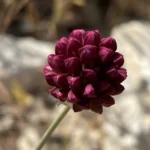Άλλιον το σφαιροκέφαλον υποείδος σφαιροκέφαλον
Etymology of Allium sphaerocephalon subspecies sphaerocephalon
The generic name "Allium" is of unknown origin, as nothing close to this word exists in Latin or Ancient Greek. It is speculated that it derives from Celtic "all", meaning "pungent, burning, hot", referring to the taste.
The specific epithet, sphaerocephalon, is derived from ancient Greek, combining "sphaira" (σφαῖρα), meaning "sphere" or "ball," and "kephalē" (κεφαλή), meaning "head." This literally translates to "spherical head" or "ball-headed," a direct and apt description of the plant's dense, globe-shaped flower clusters.
The repetition of sphaerocephalon in the subspecies name simply indicates that this is the nominate or typical subspecies, exhibiting the characteristics that gave the species its original name.
Characteristics of Allium sphaerocephalon subspecies sphaerocephalon
Distinctive Inflorescence Morphology
One of the most unique and defining characteristics of Allium sphaerocephalon subspecies sphaerocephalon is its highly distinctive inflorescence. The name itself, meaning "spherical head," perfectly describes its flower cluster. Unlike many other Allium species that might have looser or more elongated umbels, A. sphaerocephalon displays a very dense, compact, and perfectly ovoid to spherical head of flowers. This head, often reddish-purple, is typically held erect on a slender stem, making it stand out visually in its habitat. Furthermore, the individual flowers often mature from the top downwards, contributing to its unique appearance.
Habitat and Growth Habits
This particular subspecies exhibits unique preferences in its habitat, thriving in dry, often calcareous or stony soils in open, sunny locations. It is commonly found in grasslands, rocky slopes, cultivated fields, and garrigue, indicating a high tolerance for arid conditions and disturbed ground. Unlike some more robust Allium species, A. sphaerocephalon subsp. sphaerocephalon often appears quite graceful, with a relatively tall, slender stem topped by its characteristic flower head, allowing it to stand above surrounding low-lying vegetation. Its growth habit is typically clump-forming from a small bulb, producing thin, usually cylindrical leaves that often wither by the time the plant flowers.
Pollination and Dispersal Strategy
The tightly packed, spherical inflorescence of Allium sphaerocephalon subsp. sphaerocephalon also points to a specialized pollination strategy. Its dense cluster of small, nectar-rich flowers attracts a wide array of insect pollinators, particularly bees and flies, which can easily move between the closely arranged florets. The firm, compact nature of the mature seed head might also aid in seed dispersal, as the entire structure could potentially be broken off and rolled by wind or dislodged by animals, scattering seeds as it moves, a unique adaptation for colonizing new dry, open areas.
How to recognize Allium sphaerocephalon subsp. sphaerocephalon
Three Allium taxa in Cyprus have some similarities. They are Allium sphaerocephalon subspecies sphaerocephalon, Allium ampeloprasum, and Allium rotundum subsp. rotundum. Here are the key differences between the three Allium species, focusing solely on their distinguishing characteristics:
Allium sphaerocephalon subsp. sphaerocephalon
This subspecies is primarily distinguished by its dense, egg-shaped to perfectly spherical flower head composed of tightly packed, small, cup-shaped to urn-shaped flowers. These flowers are typically a distinctive reddish-purple or claret color. The overall plant is medium-sized, with relatively slender stems, and its thin, grass-like leaves often wither before or during the flowering period.
Allium ampeloprasum
Allium ampeloprasum differs significantly in its much larger overall stature, often growing to 1-1.5 meters tall, and its broader, flatter, and more prominent leaves that usually persist during flowering. Its flower heads are typically larger and looser than A. sphaerocephalon, with individual flowers being bell-shaped to urn-shaped and often pale purple to pinkish-white. Unlike the other two, it commonly forms a large, often compound bulb or a thickened stem base, which is its primary edible part.
Allium rotundum subsp. rotundum
Allium rotundum subsp. rotundum is differentiated by its bell-shaped individual flowers that are typically a darker purple or reddish-purple, even within a spherical head, and often appear less densely packed than those of A. sphaerocephalon. A key distinguishing feature is its tendency to produce numerous small bulblets around the main bulb at the base of the plant. It generally has a shorter overall stature compared to A. sphaerocephalon.
Allium sphaerocephalon subsp. sphaerocephalon in Cyprus
Allium sphaerocephalon subsp. sphaerocephalon is considered indigenous to Cyprus, meaning it is a native species to the island. It is not endemic, as its distribution extends across a much wider range, including most of Europe, North Africa, and parts of Asia. In Cyprus, it is a widespread species, found only across the central mountainous region, as well as the northwest of the island. Its adaptability allows it to thrive in diverse local environments.
In Cyprus, this subspecies is typically found in dry, open, and often disturbed habitats. Common locations include grasslands and phrygana, rocky slopes and garrigue, cultivated fields and vineyards where it can appear as a weed, and roadsides and waste places. Its preference for stony, well-drained soils makes it common in these environments, and like many resilient Allium species, it adapts well to disturbed areas. Its altitudinal range in Cyprus is quite broad, reflecting its adaptability. It can be found from near sea level (0 meters) up into the lower and mid-altitudes of the Troodos mountains and other hilly regions (1225 meters). It certainly thrives in the dry, warm to temperate conditions prevalent across much of the island.
Allium sphaerocephalon subsp. sphaerocephalon typically flowers during the late spring and early summer in Cyprus. This period generally spans from May to July. The exact timing can vary slightly depending on the specific altitude, local microclimate, and annual rainfall patterns, with plants at lower, warmer elevations often flowering earlier than those at higher altitudes. During its flowering season, its distinctive reddish-purple spherical heads become a noticeable feature of the Cypriot landscape in its preferred habitats.


